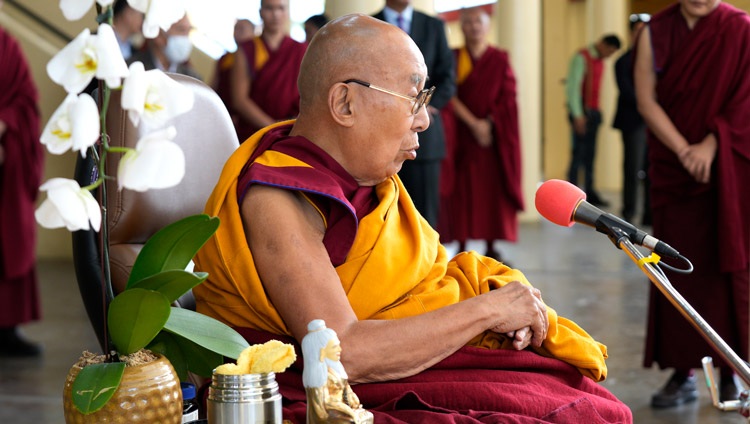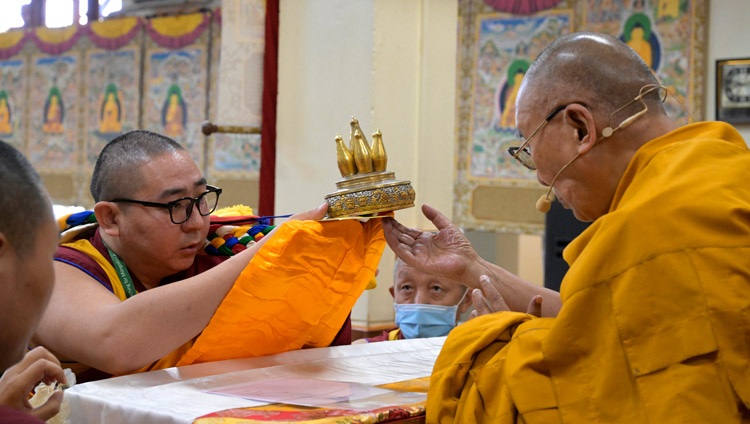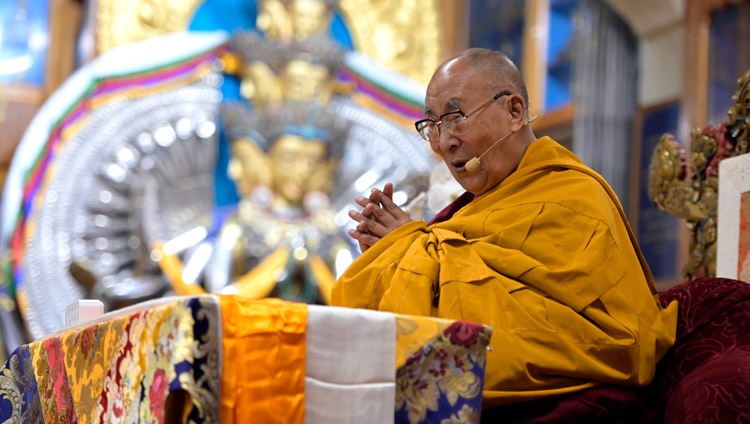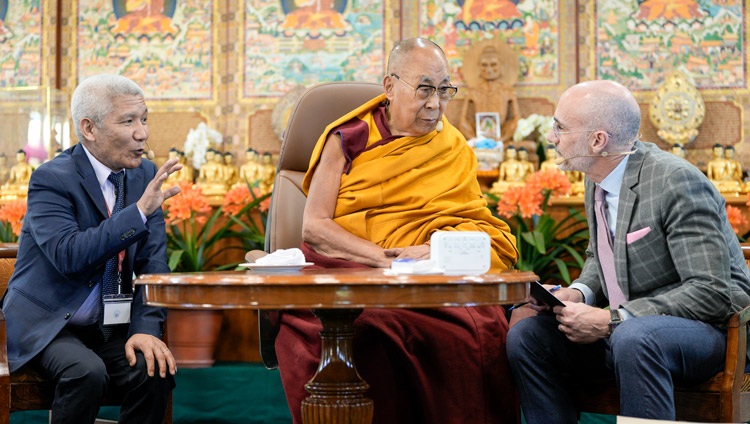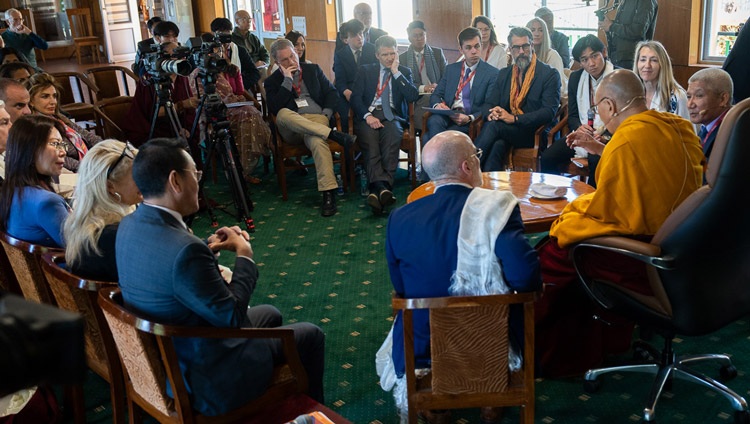Golden Jubilee of the Central Tibetan Schools Administration
OHHDL, 10 September 2012
His Holiness the Dalai Lama arrived in New Delhi this morning and in the afternoon was chief guest at an event to mark the 50th anniversary of the Central Tibetan Schools Administration (CTSA). He was joined on the platform by Union Minister of Human Resource Development, Shri Kapil Sibal, Kalon Tripa Lobsang Sangay, Joint Secretary and Chairman of the CTSA, Shri Apurva Chandra, and the Secretary for School Education and Literacy, Shrimati Anshu Vaishji. The guests were introduced by Shri Rajiv Mehrotra, who, in addition to his work as a writer and broadcaster, is Secretary of the Foundation for Universal Responsibility of HH the Dalai Lama.
In his introductory remarks, Apurva Chandra paid tribute to His Holiness the Dalai Lama as being not only the spiritual leader of the Tibetans, but also an apostle of peace. He noted that the CTSA came into existence as a result of a conversation between His Holiness and Prime Minister, Jawaharlal Nehru. Recalling that the 13th Dalai Lama too had recognised the need for modern education in Tibet, the CTSA owes much to His Holiness’s foresight. The first CTSA school in Mussoorie began with 50 students, later schools were opened in Shimla, Dalhousie and Darjeeling. Today, 8750 students are studying in 67 schools across India that come under the CTSA.
Kalon Tripa, Lobsang Sangay, a former student of the CTSA school in Darjeeling, expressed gratitude to the CTSA in general and in particular for His Holiness’s vision, which the CTSA has put into effect. He pointed out that besides himself, the present Speaker of the Tibetan Parliament in Exile and the Chief Justice were educated in Central Tibetan schools. He acknowledged the generosity of the Government and people of India in providing Tibetan children with a modern education. He noted that the ancient traditions of Buddhism and ahimsa and the contemporary practice of democracy among Tibetans follow an Indian example.
“It’s easy to thank you on the one hand,” he said, “but difficult on the other, because we can’t thank you enough.”
Minister for Human Resource Development in the Union Government, Kapil Sibal said that it was a proud moment to be celebrating the CTSA’s Golden Jubilee. However, he suggested it is not enough to bask in the glories of the past but necessary to consider what will be needed and what can be done better in the future. He quoted Douglas Adams, saying,
“’The best way to predict the future is to build it,’ which is exactly what we should be doing.”
His Holiness the Dalai Lama greeted his brothers and sisters in the audience, reminding them whenever and wherever he speaks in public he considers that he is talking to other human beings, who are fundamentally the same. He said this is worth emphasising because a great deal of trouble arises when people dwell too much on superficial differences, which tend to provoke division.
“We all want a happy life and we have a right to achieve it. Therefore, instead of quarrelling, we should help each other. This is the basis of our human values, whether we have any spiritual faith or not. We are biologically equipped to be kind and compassionate by our mother’s care, which owes nothing to religion or education, but education can strengthen these values within us. Unfortunately, sometimes modern education pays more attention to the secondary differences between us, rather than the uniting common factors.”
His Holiness described the Golden Jubilee of the CTSA as a special moment that brought to mind an image of Pandit Nehru in his office in Teen Murti Bhavan without his hat, the top of his head shiny in the light, cracking jokes in the midst of their discussions. He recalled arriving in India in April 1959 and that the immediate concern was the welfare of the 70-80,000 Tibetan refugees.
“Pandit Nehru, who was a highly educated person himself showed deep concern for the Tibetan people and particularly the welfare of their children. In 1954, when I was part of a delegation to Peking, I attended a dinner hosted by the Chinese Prime Minister, Chou En-La. He was accompanied by Pandit Nehru who he was introducing to his other guests. When he came to me he said, ‘This is the Dalai Lama’, and Nehru stopped short and stood speechless for a while. I thought then that this was a sign that he was concerned about Tibet.
“He came to meet me soon after my arrival in India in the third week of April 1959 and it was in late ‘59 or early 1960 when we were discussing education that he told me that the best way to keep the Tibet issue alive was to educate our children. There was discussion about what the medium of instruction should be, whether it should be Hindi or English. Nehru recommended English because it is an international language. After lunch he insisted that we announce the formation of the CTSA. Now, 52 years later, this organisation is still looking after our schools.”
His Holiness compared this event to the Tibetan Emperors of the 7th, 8th and 9th centuries inviting Indian teachers to Tibet, first among them the great philosopher and logician, Shantarakshita. In due course a series of Indian teachers came to Tibet and Tibetan students went to study in India. This prompted one Tibetan scholar to remark that although the Land of Snows is white in colour, until light came from India, Tibet remained dark. His Holiness said that it is quite clear that despite longstanding relations with China, Tibetans preferred to learn about Buddhism directly from Indian sources.
His Holiness concluded,
“I sometimes refer to myself as a “son of India” and a Chinese journalist once asked why, perhaps suspecting some political bias. I explained that my entire education, every particle of my brain, is seeped in Indian tradition and even my body has been nourished for more than half my life by Indian dal roti. I regard India as our Guru and us as your chela, because, just as in ancient times you taught us Buddhism, so in the present you have given us modern education. We are grateful to everyone who has contributed to this. I thank you on my own part, on behalf of the Tibetan refugee community and on behalf of the 6 million Tibetans.”

